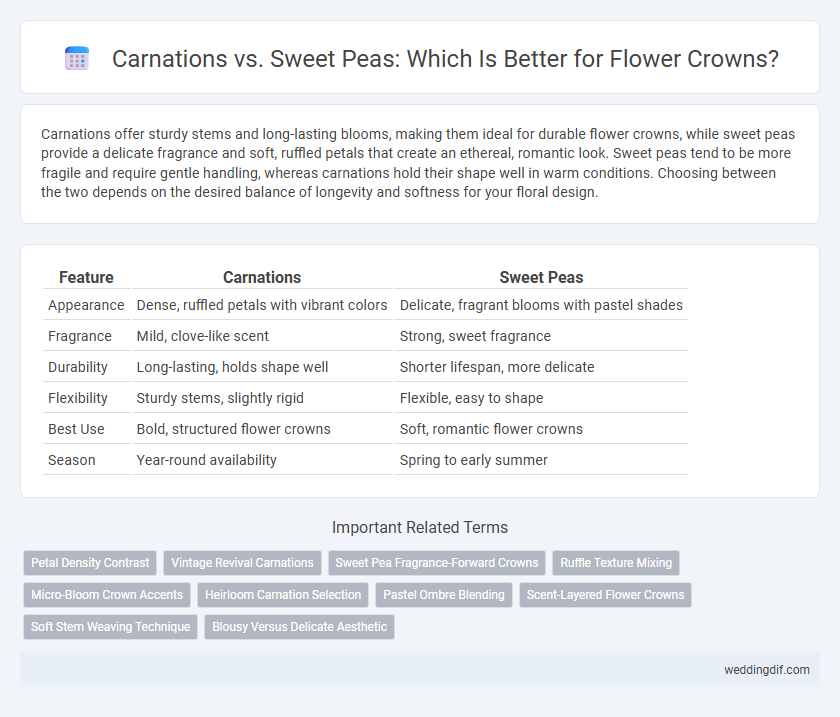Carnations offer sturdy stems and long-lasting blooms, making them ideal for durable flower crowns, while sweet peas provide a delicate fragrance and soft, ruffled petals that create an ethereal, romantic look. Sweet peas tend to be more fragile and require gentle handling, whereas carnations hold their shape well in warm conditions. Choosing between the two depends on the desired balance of longevity and softness for your floral design.
Table of Comparison
| Feature | Carnations | Sweet Peas |
|---|---|---|
| Appearance | Dense, ruffled petals with vibrant colors | Delicate, fragrant blooms with pastel shades |
| Fragrance | Mild, clove-like scent | Strong, sweet fragrance |
| Durability | Long-lasting, holds shape well | Shorter lifespan, more delicate |
| Flexibility | Sturdy stems, slightly rigid | Flexible, easy to shape |
| Best Use | Bold, structured flower crowns | Soft, romantic flower crowns |
| Season | Year-round availability | Spring to early summer |
Introduction: Carnations vs Sweet Peas for Wedding Flower Crowns
Carnations and sweet peas both offer unique qualities for wedding flower crowns, with carnations known for their durability and long-lasting vibrant colors. Sweet peas provide a delicate fragrance and soft, ruffled petals that create a romantic and whimsical look. Choosing between the two depends on desired texture, scent, and emotional symbolism for the bridal ensemble.
Historical Significance of Carnations and Sweet Peas in Weddings
Carnations have a rich historical significance in weddings, symbolizing love, fascination, and distinction since ancient times, often used in bridal bouquets and flower crowns for their longevity and vibrant colors. Sweet peas carry a Victorian-era legacy of delicate beauty and gratitude, frequently chosen for wedding flower crowns to evoke elegance and romantic charm. Both flowers offer unique historical meanings that enhance the symbolism and aesthetic appeal of wedding floral arrangements.
Color Variety: Carnations vs Sweet Peas
Carnations offer an extensive color palette ranging from vibrant reds and pinks to soft pastels and striking whites, making them a versatile choice for flower crowns. Sweet Peas provide delicate hues primarily in pinks, purples, and whites, lending a romantic and subtle aesthetic. The broader color variety of carnations allows for more dynamic and contrasting flower crown designs compared to the softer, more uniform palette of sweet peas.
Texture and Structure: Which Flower Suits Crowns Best?
Carnations offer a dense, ruffled texture and sturdy structure ideal for secure and long-lasting flower crowns, while sweet peas provide a delicate, soft appearance with a lightweight feel that may require additional support. The thick petals and robust stems of carnations enhance durability, making them better suited for intricate designs and extended wear. Sweet peas' airy blooms add elegance and fragrance but are more fragile, often necessitating careful handling to maintain crown integrity.
Fragrance Factors: Scented Crowns for the Bride
Carnations offer a subtle, spicy clove-like fragrance that provides a delicate yet enduring scent ideal for flower crowns, while sweet peas emit a sweet, honeyed aroma that is more pronounced and enveloping. The fragrance longevity of carnations often surpasses that of sweet peas, making them a practical choice for brides seeking a consistently fresh scent throughout the wedding day. Sweet peas, although highly fragrant, are more delicate and may wilt faster, potentially diminishing their aromatic impact in floral crowns.
Durability: Longevity of Carnations and Sweet Peas in Crowns
Carnations exhibit superior durability in flower crowns, lasting up to two weeks due to their sturdy petals and resistance to wilting, while sweet peas typically endure for only three to five days before drooping. The extended longevity of carnations makes them an ideal choice for long-lasting floral arrangements, especially in outdoor or event settings. Sweet peas, although delicate and fragrant, require more frequent replacement to maintain the crown's fresh appearance.
Symbolism: What Do Carnations and Sweet Peas Represent?
Carnations symbolize fascination, love, and distinction, with colors conveying specific meanings such as red for admiration and white for purity. Sweet peas represent delicate pleasures, blissful pleasure, and gratitude, often associated with departure or thank you messages. Choosing between carnations and sweet peas for flower crowns depends on the desired symbolism, whether expressing admiration or conveying a sense of gratitude and delicate beauty.
Seasonal Availability for Wedding Flower Crowns
Carnations bloom year-round, making them a reliable choice for wedding flower crowns irrespective of the season. Sweet peas have a more limited seasonal window, typically flourishing in spring and early summer, which may restrict their availability for weddings outside these months. Choosing carnations ensures consistent freshness and availability, while sweet peas offer delicate fragrance and seasonal charm during their peak growing period.
Styling Tips: Combining Carnations and Sweet Peas in Crowns
Combining carnations and sweet peas in flower crowns creates a vibrant, textured look by pairing the ruffled, sturdy carnations with the delicate, fragrant sweet peas. For optimal styling, use carnations as the base to provide structure and cluster sweet peas strategically to add softness and a subtle fragrance. Incorporating varying shades of pinks and pastels enhances the crown's visual appeal while ensuring balance and comfort for extended wear.
Budget Considerations: Cost Comparison for Flower Crowns
Carnations offer a cost-effective option for flower crowns, typically priced lower per stem compared to sweet peas, making them ideal for budget-conscious projects. Sweet peas, while more expensive due to their delicate nature and limited availability, provide a unique fragrance and vibrant colors that may justify the higher investment. Choosing between carnations and sweet peas ultimately depends on balancing budget constraints with the desired aesthetic and sensory impact for the flower crown.
Carnations vs Sweet Peas for flower crowns Infographic

 weddingdif.com
weddingdif.com